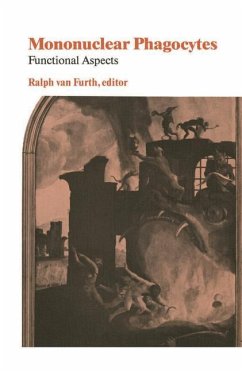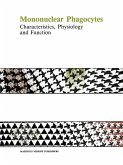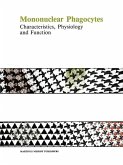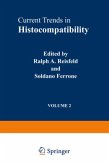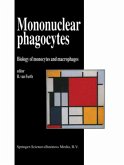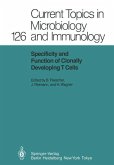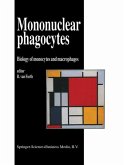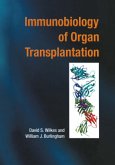Mononuclear Phagocytes
Functional Aspects
Herausgegeben:Furth, Ralph van
Mononuclear Phagocytes
Functional Aspects
Herausgegeben:Furth, Ralph van
- Broschiertes Buch
- Merkliste
- Auf die Merkliste
- Bewerten Bewerten
- Teilen
- Produkt teilen
- Produkterinnerung
- Produkterinnerung
The term mononuclear phagocyte covers a group of cells including the macrophages in the tissues and the ancestors of these cells, i. e. , the monocytes in the peripheral blood, and their precursors in the bone marrow, the promonocytes and monoblasts. Among the cells originating in the bone marrow, the mononuclear phagocytes constitute a separate cell line. The effector cell of this line is the macrophage, which plays an important role in the host defence against infective agents and neoplastic cells as well as in the removal of antigens, antigen-antibody complexes, effete cells, and damaged…mehr
Andere Kunden interessierten sich auch für
![Mononuclear Phagocytes Mononuclear Phagocytes]() van FurthMononuclear Phagocytes525,99 €
van FurthMononuclear Phagocytes525,99 €![Mononuclear Phagocytes Mononuclear Phagocytes]() Mononuclear Phagocytes242,99 €
Mononuclear Phagocytes242,99 €![Current Trends in Histocompatibility Current Trends in Histocompatibility]() Current Trends in Histocompatibility81,99 €
Current Trends in Histocompatibility81,99 €![Mononuclear Phagocytes Mononuclear Phagocytes]() Mononuclear Phagocytes403,99 €
Mononuclear Phagocytes403,99 €![Specificity and Function of Clonally Developing T Cells Specificity and Function of Clonally Developing T Cells]() Specificity and Function of Clonally Developing T Cells81,99 €
Specificity and Function of Clonally Developing T Cells81,99 €![Mononuclear Phagocytes Mononuclear Phagocytes]() van FurthMononuclear Phagocytes404,99 €
van FurthMononuclear Phagocytes404,99 €![Immunobiology of Organ Transplantation Immunobiology of Organ Transplantation]() Immunobiology of Organ Transplantation307,99 €
Immunobiology of Organ Transplantation307,99 €-
-
-
The term mononuclear phagocyte covers a group of cells including the macrophages in the tissues and the ancestors of these cells, i. e. , the monocytes in the peripheral blood, and their precursors in the bone marrow, the promonocytes and monoblasts. Among the cells originating in the bone marrow, the mononuclear phagocytes constitute a separate cell line. The effector cell of this line is the macrophage, which plays an important role in the host defence against infective agents and neoplastic cells as well as in the removal of antigens, antigen-antibody complexes, effete cells, and damaged tissues. Metchnikoff ( r 892) was the first to describe the macrophage and the microphage, the latter now being called polymorphonuclear leucocyte or granulocyte, and to recognize that phagocytes not only serve as scavengers, but also play an important role in the host defence against micro-organisms. However, Haeckel ( r862) had made the first observa tion of endocytosis 30 years before. In his book 'Die Radiolaren' published in r862, Haeckel wrote: I first observed this phenomenon in May, 1859, in a specimen of Thetis fimbria, which I had injected with an aqueous suspension of fine Indigo particles in connection with a study of the vascular system.
Hinweis: Dieser Artikel kann nur an eine deutsche Lieferadresse ausgeliefert werden.
Hinweis: Dieser Artikel kann nur an eine deutsche Lieferadresse ausgeliefert werden.
Produktdetails
- Produktdetails
- Verlag: Springer / Springer Netherlands
- Artikelnr. des Verlages: 978-94-009-8795-1
- Softcover reprint of the original 1st ed. 1980
- Seitenzahl: 2052
- Erscheinungstermin: 23. August 2014
- Englisch
- Abmessung: 235mm x 155mm x 111mm
- Gewicht: 3077g
- ISBN-13: 9789400987951
- ISBN-10: 9400987951
- Artikelnr.: 41323806
- Herstellerkennzeichnung Die Herstellerinformationen sind derzeit nicht verfügbar.
- Verlag: Springer / Springer Netherlands
- Artikelnr. des Verlages: 978-94-009-8795-1
- Softcover reprint of the original 1st ed. 1980
- Seitenzahl: 2052
- Erscheinungstermin: 23. August 2014
- Englisch
- Abmessung: 235mm x 155mm x 111mm
- Gewicht: 3077g
- ISBN-13: 9789400987951
- ISBN-10: 9400987951
- Artikelnr.: 41323806
- Herstellerkennzeichnung Die Herstellerinformationen sind derzeit nicht verfügbar.
1 Cells of the mononuclear phagocyte system Nomenclature in terms of sites and conditions.- 2 Peroxidase and catalase in monocytes, macrophages, epithelioid cells and giant cells of the rat.- 3 Changes in peroxidase distribution within organelles of blood monocytes and peritoneal macrophages after surface adherence in vitro and in vivo.- 4 Development of exudate-resident macrophages, on the basis of the pattern of peroxidatic activity in vivo and in vitro.- 5 The vacuolar apparatus of alveolar macrophages and the turnover of surfactant.- 6 Properties of Kupffer cells.- 7 Origin and structure of the osteoclast.- 8 Veiled cells resembling Langerhans cells.- 9 Characteristics, origin and kinetics of human and murine mononuclear phagocytes.- 10 The origin and properties of peripheral lymph mononuclear phagocytes.- 11 Humoral control of monocyte production during inflammation.- 12 Long-term cultures of murine bone marrow mononuclear phagocytes.- 13 Effector cell functions in long-term culture of murine, prosimian, and human bone marrow.- 14 Formation of colonies by mononuclear phagocytes outside the bone marrow.- 15 Regulation of macrophage production by a colony-stimulating factor.- 16 Functions of macrophage cell lines.- 17 Gradients of chemotactic factors in various assay systems.- 18 The locomotor behaviour of human blood monocytes in chemotactic and chemokinetic environments and the role of substratum in monocyte locomotion.- 19 Alteration of macrophage and monocyte membrane potential by chemotactic factors.- 20 MIF/MAF-macrophage interactions: biochemical characterization of a putative glycolipid receptor for MIF and the existence and properties of two distinct MIFs.- 21 Lymphokine-induced modulation of macrophage functions.- 22 An inhibitor of macrophage accumulationproduced by neoplasms: its role in abrogating host resistance to cancer.- 23 Membrane flow during endocytosis.- 24 Membrane recycling (shuttle?) in endocytosis.- 25 The iodination and turnover of macrophage plasma membrane polypeptides.- 26 Macrophage ecto-enzymes: their identification, metabolism, and control.- 27 Membrane lipids and the control of endocytosis.- 28 Surface functions in dividing macrophages.- 29 Fc receptors on mouse macrophages.- 30 Structural characteristics of Fc receptors on macrophages.- 31 Quantitative studies on the interaction of macrophages with antibody and immune complexes.- 32 Hormone receptors and hormonal regulation of macrophage physiological functions.- 33 In vivo and in vitro evidence for a lysosomal enzyme uptake system in macrophages.- 34 Cellular recognition by phagocytes: role of lectin-like receptor(s).- 35 Phagocytosis.- 36 Modulation of macrophage plasma membrane receptors for IgG and complement.- 37 Genetic and functional studies of continuous macrophage-like cell lines.- 38 Contractile proteins and the mechanism of phagocytosis in macrophages.- 39 Factors modifying the fusion of phagosomes and lysosomes: art, fact, and artefact.- 40 Manipulations of phagosome-lysosome fusion in cultured macrophages: potentialities and limitations.- 41 Cyclic nucleotides and phagosome-lysosome fusion in mouse peritoneal macrophages.- 42 Determinants of phagosome-lysosome fusion in mouse macrophages.- 43 Oxygen intermediates and the microbicidal event.- 44 Release of superoxide anion by macrophages: effect of in vivo or in vitro priming.- 45 The release of hydrogen peroxide from mononuclear phagocytes and its role in extracellular cytolysis.- 46 Oxidative metabolism of mononuclear phagocytes.- 47 The oxygen metabolism of human blood monocytes andneutrophils.- 48 Effects of oxygen on metabolic patterns and endocytosis of macrophages.- 49 Lysozyme and plasminogen activator: constitutive and induced secretory products of mononuclear phagocytes.- 50 Modulation of macrophage plasminogen activator secretion.- 51 The synthesis of arachidonic acid oxygenation products by various mononuclear phagocyte populations.- 52 Generation of tissue thromboplastin by human monocytes.- 53 Secretion of lysosomal enzymes by macrophages.- 54 Synthesis and release of complement components by macrophages.- 55 The stimulation of mononuclear phagocytes by components of the classical and the alternative pathways of complement activation.- 56 Complement, coagulation and mononuclear phagocytes.- 57 Extracellular stimulation of intracellular killing.- 58 Respiratory pathways of macrophages - cellular localization and relation to cidal activity.- 59 Macrophage activation by interferon or interferon inducers.- 60 Macrophage activation by IgE.- 61 The effect of complement on the degradation of soluble immune aggregates by Kupffer cells and peritoneal macrophages in vitro.- 62 Macrophage activation in vitro by phagocytosis.- 63 Induction of macrophage microbicidal activity.- 64 Interactions of macrophages with intravacuolar bacteria and protozoa.- 65 Cytotoxic and microbicidal properties of macrophages.- 66 Significance of systemic macrophage activation in response to tumor growth.- 67 Regulation of macrophage non-specific tumoricidal capability.- 68 Distinctive characteristics of host tumor resistance in a rat fibrosarcoma model system.- 69 Intracellular killing, degradation, metabolic activity, and increase in ?-galactosidase activity as markers for activated macrophages.- 70 Cytotoxicity of human monocytes against sensitized erythrocytes.-71 Dendritic cells and macrophages - current knowledge of their distinctive properties and functions.- 72 Reticulum cells and macrophages in the immune response.- 73 Multiple interactions between listeria-immune T lymphocytes and macrophages: regulation by the major histocompatibility gene complex.- 74 Role of macrophages in the in vitro induction and regulation of antibody responses.- 75 Physical and functional macrophage-lymphocyte interactions in antigen recognition by T lymphocytes.- 76 Expression of Ir genes and Ia antigens by adherent accessory cells required for antigen- specific antibody-forming cell responses.- 77 Summation.
1 Cells of the mononuclear phagocyte system Nomenclature in terms of sites and conditions.- 2 Peroxidase and catalase in monocytes, macrophages, epithelioid cells and giant cells of the rat.- 3 Changes in peroxidase distribution within organelles of blood monocytes and peritoneal macrophages after surface adherence in vitro and in vivo.- 4 Development of exudate-resident macrophages, on the basis of the pattern of peroxidatic activity in vivo and in vitro.- 5 The vacuolar apparatus of alveolar macrophages and the turnover of surfactant.- 6 Properties of Kupffer cells.- 7 Origin and structure of the osteoclast.- 8 Veiled cells resembling Langerhans cells.- 9 Characteristics, origin and kinetics of human and murine mononuclear phagocytes.- 10 The origin and properties of peripheral lymph mononuclear phagocytes.- 11 Humoral control of monocyte production during inflammation.- 12 Long-term cultures of murine bone marrow mononuclear phagocytes.- 13 Effector cell functions in long-term culture of murine, prosimian, and human bone marrow.- 14 Formation of colonies by mononuclear phagocytes outside the bone marrow.- 15 Regulation of macrophage production by a colony-stimulating factor.- 16 Functions of macrophage cell lines.- 17 Gradients of chemotactic factors in various assay systems.- 18 The locomotor behaviour of human blood monocytes in chemotactic and chemokinetic environments and the role of substratum in monocyte locomotion.- 19 Alteration of macrophage and monocyte membrane potential by chemotactic factors.- 20 MIF/MAF-macrophage interactions: biochemical characterization of a putative glycolipid receptor for MIF and the existence and properties of two distinct MIFs.- 21 Lymphokine-induced modulation of macrophage functions.- 22 An inhibitor of macrophage accumulationproduced by neoplasms: its role in abrogating host resistance to cancer.- 23 Membrane flow during endocytosis.- 24 Membrane recycling (shuttle?) in endocytosis.- 25 The iodination and turnover of macrophage plasma membrane polypeptides.- 26 Macrophage ecto-enzymes: their identification, metabolism, and control.- 27 Membrane lipids and the control of endocytosis.- 28 Surface functions in dividing macrophages.- 29 Fc receptors on mouse macrophages.- 30 Structural characteristics of Fc receptors on macrophages.- 31 Quantitative studies on the interaction of macrophages with antibody and immune complexes.- 32 Hormone receptors and hormonal regulation of macrophage physiological functions.- 33 In vivo and in vitro evidence for a lysosomal enzyme uptake system in macrophages.- 34 Cellular recognition by phagocytes: role of lectin-like receptor(s).- 35 Phagocytosis.- 36 Modulation of macrophage plasma membrane receptors for IgG and complement.- 37 Genetic and functional studies of continuous macrophage-like cell lines.- 38 Contractile proteins and the mechanism of phagocytosis in macrophages.- 39 Factors modifying the fusion of phagosomes and lysosomes: art, fact, and artefact.- 40 Manipulations of phagosome-lysosome fusion in cultured macrophages: potentialities and limitations.- 41 Cyclic nucleotides and phagosome-lysosome fusion in mouse peritoneal macrophages.- 42 Determinants of phagosome-lysosome fusion in mouse macrophages.- 43 Oxygen intermediates and the microbicidal event.- 44 Release of superoxide anion by macrophages: effect of in vivo or in vitro priming.- 45 The release of hydrogen peroxide from mononuclear phagocytes and its role in extracellular cytolysis.- 46 Oxidative metabolism of mononuclear phagocytes.- 47 The oxygen metabolism of human blood monocytes andneutrophils.- 48 Effects of oxygen on metabolic patterns and endocytosis of macrophages.- 49 Lysozyme and plasminogen activator: constitutive and induced secretory products of mononuclear phagocytes.- 50 Modulation of macrophage plasminogen activator secretion.- 51 The synthesis of arachidonic acid oxygenation products by various mononuclear phagocyte populations.- 52 Generation of tissue thromboplastin by human monocytes.- 53 Secretion of lysosomal enzymes by macrophages.- 54 Synthesis and release of complement components by macrophages.- 55 The stimulation of mononuclear phagocytes by components of the classical and the alternative pathways of complement activation.- 56 Complement, coagulation and mononuclear phagocytes.- 57 Extracellular stimulation of intracellular killing.- 58 Respiratory pathways of macrophages - cellular localization and relation to cidal activity.- 59 Macrophage activation by interferon or interferon inducers.- 60 Macrophage activation by IgE.- 61 The effect of complement on the degradation of soluble immune aggregates by Kupffer cells and peritoneal macrophages in vitro.- 62 Macrophage activation in vitro by phagocytosis.- 63 Induction of macrophage microbicidal activity.- 64 Interactions of macrophages with intravacuolar bacteria and protozoa.- 65 Cytotoxic and microbicidal properties of macrophages.- 66 Significance of systemic macrophage activation in response to tumor growth.- 67 Regulation of macrophage non-specific tumoricidal capability.- 68 Distinctive characteristics of host tumor resistance in a rat fibrosarcoma model system.- 69 Intracellular killing, degradation, metabolic activity, and increase in ?-galactosidase activity as markers for activated macrophages.- 70 Cytotoxicity of human monocytes against sensitized erythrocytes.-71 Dendritic cells and macrophages - current knowledge of their distinctive properties and functions.- 72 Reticulum cells and macrophages in the immune response.- 73 Multiple interactions between listeria-immune T lymphocytes and macrophages: regulation by the major histocompatibility gene complex.- 74 Role of macrophages in the in vitro induction and regulation of antibody responses.- 75 Physical and functional macrophage-lymphocyte interactions in antigen recognition by T lymphocytes.- 76 Expression of Ir genes and Ia antigens by adherent accessory cells required for antigen- specific antibody-forming cell responses.- 77 Summation.

